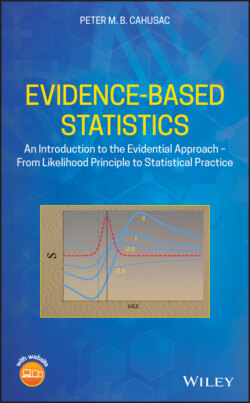Читать книгу Evidence-Based Statistics - Peter M. B. Cahusac - Страница 17
1.2.1 Different Statistical Approaches
ОглавлениеThere are three main statistical approaches to data analysis. These are neatly summarized by Royall's three questions that follow the collection and analysis of some data [24]:
1 What should I do?
2 What should I believe?
3 How should I interpret the evidence?
They describe the different ways in which the data are analyzed and interpreted. Each approach is important within their specific domain. The first of these is pragmatic, where a decision must be made on the basis of the analysis. It represents the frequentist approaches of statistical tests and hypothesis testing. Typically, either the null hypothesis is rejected (evidence for an effect is found) or not rejected (insufficient evidence found). The decision is based upon a critical probability, usually .05. The significance testing approach measures the strength of evidence against the null hypothesis by the diminutiveness of a calculated probability of obtaining the data (or more extreme) assuming the null hypothesis is true. This probability is known as a p value.
The second approach represents the strength of belief for a specified hypothesis. It too is based upon probability and is conditioned by the probability of the hypothesis prior to the collection of the data. If the prior probability is known, then the calculation using Bayes' theorem logically provides the (posterior) probability for the specified hypothesis.
The third approach also uses probability but provides objective evidence which is expressed as the likelihood for one hypothesis versus another in the form of a LR. The LR is not a probability but a relative measure of evidence for competing hypotheses. The technical meaning of the word ‘likelihood’ in statistics is very similar to its use in common parlance by non-statisticians. For example we might say, seeing dark clouds in the sky, ‘there is a greater likelihood for rain than sunshine this afternoon’.
When the LR is transformed into the natural logarithm, it is known as the support, denoted S. The support quantifies the comparative evidence on a scale of −∞ to +∞, with midpoint 0 representing no evidence in favour of either hypothesis. Unlike the use of p, S is a graded measure of evidence without clear cutoffs or thresholds.
If the collected data are not strongly influenced by prior considerations, it is somewhat reassuring that the three approaches usually reach the same conclusion. However, it is not difficult to find examples of where the likelihood evidence points one way and the hypothesis testing decision points the other (see Section 3.7, and de Winter and Cahusac [25], p. 89 and Dienes [6], p. 127)
